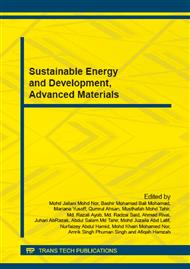p.26
p.32
p.38
p.44
p.49
p.53
p.59
p.64
p.70
Thiosulfinates Concentration in Garlic Extract at Different Storage Temperatures
Abstract:
Thiosulfinates (TS) found in garlic extract is the main compound which determines the effectiveness of this plant towards inhibition. TS shows its ability to inhibit other compounds has been proved by several researchers especially in medical application. However, TS is an unstable compound and transform into more stable compound with time. Therefore, TS concentration may decrease. During analysis, garlic extract was stored at two different temperatures: 25°C and 4°C to determine the suitable temperature for TS to maintain its composition in garlic extract for a long time. After 10 and 60 storage days, the extract was tested for its TS content by reaction of L-cysteine and 5,5'-dithiobis-(2-nitrobenzoic acid), DTNB with garlic extract. As result, TS concentration was high and shows slight difference for both storage temperatures at 10 storage days. Meanwhile, at 60 storage days, TS concentration at 25°C has lower reading compared to 4°C. This is due to TS rapid transformation to other compound at warmer temperature. Low concentration of TS reduces garlic extract efficiency towards inhibition. Therefore, the best storage temperature for garlic extract long term analysis is at 4°C.
Info:
Periodical:
Pages:
49-52
Citation:
Online since:
November 2014
Authors:
Keywords:
Price:
Сopyright:
© 2015 Trans Tech Publications Ltd. All Rights Reserved
Share:
Citation:


